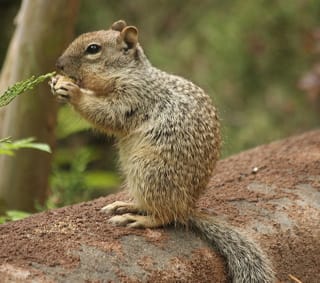This guide initially displays all common mammals. Use the selectors below to view mammals of a particular shape, include rare mammals, or search for them by name.
Mammals are defined as warm-blooded vertebrates with hair or fur and sweat glands — in the females mammary glands, modified sweat glands, produce milk to nourish the young. Most mammals develop a placenta which enables the feeding of the fetus during gestation and give birth to live young. In addition, although most mammals walk on land, many have specific adaptations that allow them to swim, fly, leap between tree branches or even dig extensive tunnels. Many wild mammals are used for both food and fur. while other have been domesticated for their agricultural and scientific importance.
New Mexico ranks high for mammalian diversity in the states in the US and the Pajarito Plateau is home to many of these species. This guide describes all of the larger wildlife found in the area as well as the more common smaller animals with the most abundant being rodents. Local species range from carnivores like the mountain lion and bobcat to ruminants like elk and deer to to several varieties of bats.
Mammal References
Biota Information System of New Mexico
Bogen et al. 1998 Continued Studies of Bat Species of Concern in the Jemez Mountains, New Mexico [PDF]
eNature
Frey et al. 2006 Checklist of New Mexico Mammals [PDF]
New Mexico Tech Mammalian Field Guide
Smithsonian National Museum of Natural History North American Mammals
Threatened, Endangered and Sensitive Species Profile – Los Alamos Laboratory Lands [PDF]
Tyrell and Brack 1992 Survey for Bats in the Los Alamos National Environmental Research Park
Subject Area Experts (all guides)
Steve Cary (butterflies)
Beth Cortright (insects)
Terry Foxx (invasive plants)
Leslie Hansen (mammals)
Richard Hansen (fish, mammals)
Dorothy Hoard (butterflies, trees)
Chick Keller (flowers, herbarium)
Shari Kelley (geology)
Kirt Kempter (geology)
Garth Tietjen (reptiles)
David Yeamans (birds)
Web Development and Content Management
Pat Bacha
Jennifer Macke
Graham Mark
Akkana Peck
Contact
Please contact us for local nature questions and sightings. We welcome comments, corrections, and additions to our guides.
For more information about local nature, please visit our Nature Blog or subscribe to PEEC This Week.
Make Selection
 Photo: J. N. Stuart |  Golden-mantled Ground Squirrel(Callospermophilus lateralis, Spermophilus lateralis)Family: Sciuridae (Squirrels, Chipmunks, Marmots, and Prairie Dogs) Size: 9.5 - 12.1 in (24 - 31 cm) Status: native; locally common Habitat: moist coniferous or mixed forest, open woodlands, brushy forest-edge habitats, dry margins of mountain meadows, and rocky slopes Typical location: Jemez Mountains The Golden-mantled Ground Squirrel is similar to a chipmunk with the same overall appearance. However, the ground squirrel lacks the chipmunk’s facial stripes. Golden-mantled Ground Squirrels eat almost anything including seeds, nuts, berries, insects, eggs and fungi. They are often seen in sunny disturbed areas searching for food. In general they are solitary animals and live in long shallow burrows that they dig themselves. They hibernate during winter. In summer they cache food in their nests for when they awake in spring. They are capable of carrying food in their cheek pouches while still running at full speed. Tracks Info Photos Distribution |
 Photo: J. N. Stuart |  Rock Squirrel, Ground Squirrel(Otospermophilus variegatus, Spermophilus variegatus)Family: Sciuridae (Squirrels, Chipmunks, Marmots, and Prairie Dogs) Size: 17 - 21 in (43 - 53 cm) Status: native; common Habitat: rocky locales including boulder piles, hills, oak-juniper growth, towns Rock Squirrels have long bushy tails and look like tree squirrels. However, although they can climb trees they usually do not. They typically nest in a complex burrow near a good lookout spot. They are social and live in small colonies. The Rock Squirrel is predominantly an herbivore and is generally active in the early morning and late afternoon. When it is very hot it may enter a prolonged state of dormancy or estivation. These squirrels may not hibernate during the colder months. They have a short, sharp whistling call that they use when alarmed. Tracks Info Photos Distribution Featured |
